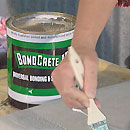Mosaic Stepping Stones
Rita Hill showed how to turn a boring concrete paver into a beautiful piece of garden artwork.
You will need:
ready made concrete stepping stones Bondcrete (1/2 litre does one stepping stone) old plates, tiles, glass tiles or mosaic tiles old towel hammer cement /sand mix spatulas and/or adhesive spreader tile cutters sponge slate/pebble sealer (if using porous tiles)
What to do:
- Paint the concrete stepping stone with straight Bondcrete so that the cement mix will bond to it. Leave for 12 hours to dry.
- Prepare your tiles while you’re waiting for the Bondcrete to dry. Wrap the tiles/plates in an old towel and smash with a hammer. You may need to unwrap the towel at some stage and gently smash the tiles into smaller pieces. Safety gear (such as goggles and mask) is necessary for protection against any small shards that go flying off the tiles. Do this job outside on a hard surface. Separate the broken pieces into colours and approximate size groups. This will make the laying stage easier.
- When the stepping stone is dry make up your cement mix (wear a dust mask and gloves). Mix the cement with water to a porridge consistency. Before mixing, add Bondcrete to the water to make the cement stronger – one part Bondcrete to four parts water (as per instructions on Bondcrete container).
- Pour the cement mix onto the stepping stone and spread with the spatula. You can use an adhesive spreader at the last stages to even out the cement bed. Make sure the mix is right up to all the edges of the stepping stone.
- Draw a simple design into the wet mortar and start laying the broken pieces into the mortar, leaving enough space between the pieces for grouting. (Tip: use a pair of tile cutters to cut any pieces of tile that aren’t quite the right shape.) As long as your cement mix isn’t too stiff you should have about half and hour to work on your design. Cement mixes will start drying straight away so don’t waste time at this stage. If you’re worried about it drying you can lay your cement bed in stages, working your tiles in as you go. Try not to get cement on the tops of the tiles. If you do, wipe it off while the cement’s still wet. When finished, set your stepping stone aside for three days to dry.
- Grouting is done with the sand cement mix, again with Bondcrete, but make it a runnier consistency by adding more water. Pour the grout onto the stepping stone and spread with the spatula, then with a gloved hand spread the grout evenly over the whole stepping stone to create an even, smooth surface. Wipe off any excess grout and leave to dry for about 20 minutes. Wipe off all excess grout using a kitchen sponge, rinsed every now and then in clean water. Set aside once again to dry for at least a day.
- If you are using porous tiles, seal the stepping stone with a sealer.
- Stepping stones should be laid just a little above the soil level, but under the grass level so you can mow over them easily. Lay them on a bed of sand or mortar. Wiggle into place and pack the edges with sand or soil.
Further information
Pavers: available from nurseries and landscape suppliers. We paid $5.95 for square ones, and $6.15 for round ones.
Hardware:
Bondcrete costs about $38 for 2L, cement and sand mix $5 for 5Kg bag, adhesive spreader $3, tile cutters $33 and slate/pebble sealer $28 for 1L. We shopped at Mitre 10 (phone 1800 777 850 for your nearest store) but any hardware store would stock these products.
Tiles: mosaic glass tiles cost around $8 a pack from craft stores such as Lincraft. Tumbled marble mosaics cost approx. $20 per sheet, and ceramic mosaics cost around $10 per sheet. A box of tile seconds costs about $20 from tile shops.
This story is in the July 2001 edition of the Burke’s Backyard Magazine, available at newsagents for $4.60.



